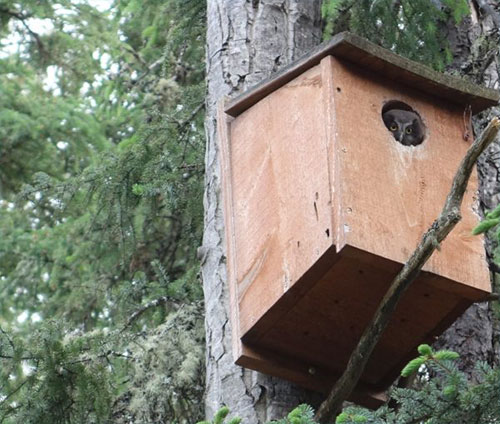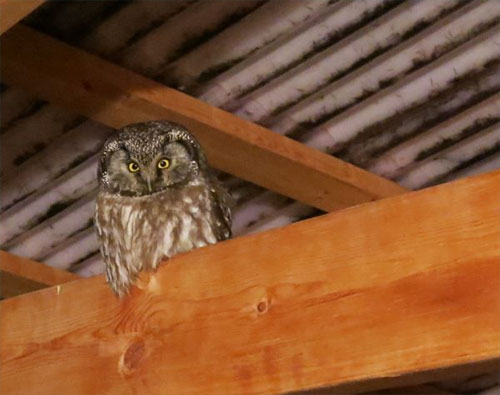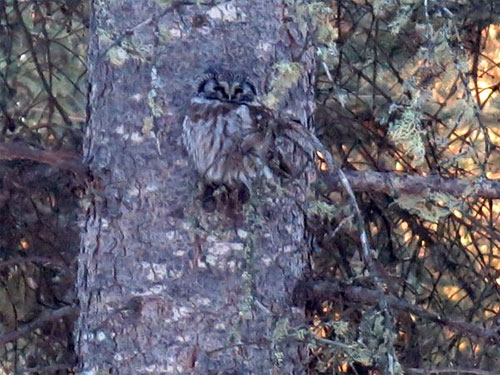Alaska Science Boreal owls perform by daylightBy NED ROZELL
June 29, 2018
With a vole in its talons, the hand-sized bird perched on a branch outside a wooden box nailed to the tree. After a quick scan of the activity below, the owl bent and grabbed the vole with its beak. It fluttered up, hovered, and slam-dunked the vole through the hole.
The owl then disappeared into the shadows of the spruce forest. Scratching noises came from the nest box as the adult female within tore apart the vole into pieces her hatchlings could swallow. Over much of their range, boreal owls operate in the dark every night. They live south to Colorado and in a forested belt around the northern part of the globe. People know boreal owls in Europe and Russia as the Tengmalm’s owl. Here in Alaska, biologist Tim Craig found boreal owls in his nest boxes north of Coldfoot along the Dalton Highway, almost to where there are no trees. But — fun fact — he found none in his string of boxes just south of Coldfoot on the highway. In the far North, where there currently is no night, nocturnal animals like flying squirrels and owls need to go about their business in daylight. “None of these animals out there are sacked out for eight hours like we are,” said UAF ecologist Knut Kielland, who studies lynx and hares, among other creatures.
Mad increases in daylight cue chemical changes in the brain that enable animals to ditch their circadian rhythms, Kielland said. Moose, for example, can strip willows for two hours then lie down for a few hours, repeating that cycle all day and all night. Though owls, bats and flying squirrels are more active in the dimmest part of the day, they are not living the life they are in Washington state. As the Fairbanks backyard party continued past midnight, the male owl returned. He carried another vole. During studies in the early 2000s, biologist Jack Whitman found that boreal owls outside McGrath and Fairbanks fed mostly red-backed voles to their nestlings, sometimes switching to meadow voles when they were available and grasses and sedges were short. Owls fed their young other birds, mammals and insects, too, but voles were by far the number one prey of Aegolius funereus. About that Latin name: The genus name Aegolius is a type of screech owl thought to be a bird of ill omen. Funereus means dark, deathlike, funereal. It is also the name of a death metal band from New Jersey. Seems a bit heavy for one of the friendlier-looking owls out there.
The boreal owl’s roundish face is disk-shaped, like a radar antenna bouncing the slightest rustle of twigs to the owl’s ears. The boreal owl is one of few creatures with a lopsided skull — one ear is lower than the other. This asymmetrical head further helps a boreal owl pinpoint the skitter of a vole through leaves. The male owl above the party seemed to be on a regular commute from his vole hunting grounds to the owl box. For all we knew, he might be delivering to two boxes. Near McGrath, Jack Whitman found the rear half of one snowshoe hare in one box and the matching front half in another, just 1,200 feet away. “I suspect one male (was) maintaining two females with broods at these particular sites,” he wrote. The humans walked away from the party after the sun set but before it rose again at 3 a.m. I returned a few days later and saw the dusky head of a boreal owl chick peering out of the box. Soon, it will take its first leap into the world, beginning a life of three or four bright summers. If that chick is a male, (females often leave the area), the owl will probably haunt these same spruce on the darkest days of December.
Representations of fact and opinions in comments posted are solely those of the individual posters and do not represent the opinions of Sitnews.
|
||||||



